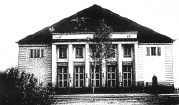Knobelsdorff in Mecklenburg?The Socialist Mestlin - a Sample Village Without SuccessorsShortly after the founding of the GDR, the SED - leadership began with a radical restructuring of the production ratio of industry and agriculture, drawn out in the Five-Year-Plans. In the rural areas, one followed the soviet examples with the famous collectivation of the land of peasants, that partly had only just received their land themselves. Instead of the single economizing farms, came the collective farms (LPG), to which the formerly self-supporting peasants had to tribute their land, partly also their livestock, their stables, sheds and barns. This kind of combined production of agricultural products under standardized authority did not prove to be unefficient. However, one thing became obvious with time - the loss of traditional rural social-structures. These transitional processes in rural areas, has however been planned by the policital leadership. The rural working- and living circumstances should become identical to those of the industrial workers. Under these circumstances, an entirely new socialist image of man should form. In fact, the centralization of agricultural work achieved a progressing proletarisation of the agricultural laborers and cattle-breeders, that had been incapacitated in many ways, and the concentrated production achieved a continuous transformation of rural identity, as well as massive destruction of natural resources. Some of the measures that had been taken in order to adjust the rural to the urban life, were the building of schools and the development of culture and folk art. At the beginning of the fifties, it had been decided that a socialist sample village should be formed in Mecklenburg, that should offer the same possibilities as a city, such as cultural offers, education and shopping possibilities. As a place for this socialist sample village, Mestlin, in the regional district of Parchim, lying in the heart of the district of Schwerin with more than 1000 inhabitants, had been chosen. A Promissing BeginningIn July 1954, the council of the district Schwerin approves the architect's plan of a project that this politically important council had commissioned itself, and for which the architect Erich Bentrup had delivered the draft. His task was to unify a center of cultural activities in spatial harmony and economical effectivity under one roof. A few of the functions that it should have were a an auditorium for educational events, a gymnastics- and dancing room, a club room with a restaurant and most importantly a theatre with all necessary functioning rooms, the proscenium, the main stage and the back stage, an orchestra pit, the artists cloakroom, the flies, a set- and a props room, and so on, a spot light room and a projectors room, visitors lobby and a box office room.
Bentrup solved this task in a surprisingly conventional way, by modifying and refining the important early theatre of Prussia, the royal opera house Unter den Linden, built by Georg Wenceslauss von Knobelsdorff between 1740 and 1743, so that it would fit the current demands.
Similarities of both drafts refer to
Only the lobby and the cash box room have been arranged parallelly to the auditorium, since that had a parquet for approx. 500 seats, and without balconies and boxes and their staircases and covered walks it took up much less room. The affinity of the two buildings, that had been tolerated by the clients, because they didn't notice it, is not entirely without a certain piquancy. Only a few years earlier, the city castle of the Hohenzollers in Berlin had been destructed at Ulbricht's behest. The opera house, that Friedrich II. - epitome of the enlightened feudal sovereign of the Prussian Absolutism in the 18th century - commissioned to build for representation purposes and for his own joy, the temple of muse Unter den Linden in Berlin, should here on the land, in the village of Mestlin help educate the new, unexploited, free people and crown the vision of a socialist village.
If the cultural house of Mestlin, this multi functional, architectonical jewel in the spirit of Knobelsdorff, could not tribute to this, it was first of all, due to the illusionary aims, that it had been dedicated. As a detour of Mecklenburg's district theatre Parchim it could not develop an own "life". In order to fill the theatre hall, almost all of the adults in the employable age had to go to the events. The mobility of the rural inhabitants at that time - also keeping in mind the lack of spare time - had been totally underdeveloped. Visitors from neighboring municipalities had to go through complicated bus tours. These facts became more and more important when the content of the events hardly motivated to visit. A number of various causes finally led to the unacknowledged break down of the culture in the socialist sample village. In comparison to the medium TV, that should soon reach each part of the country, the cultural house of Mestlin was to live in the shadows from the middle of the sixties on. Today's SituationThe neglect in content over the period of three decades can today be seen on the outside of the fourty-year old building, which has been scheduled, as well. The fact that a disco organizer has done alterations in the auditorium and caused damages to the decor in the first half of the nineties is especially regrettable. In order to remove those traces and to save the building from further decay, a development union "Kulturhaus Mestlin" e.V. (registered association) has been founded, whose first chairman is Torsten Kort, who lives in Mestlin. Under his leadership, the club room has been reconstructed and a revival in content of the house as a place for events and a youth club has been initiated. The other rooms cannot be used at the moment (auditorium and stage) or can only be used in parts (kitchen, sanitary facilities). © 1999 Peter Huth, member of the association "Förderverein Kulturhaus" - any processing or spreading, also in parts, only with allowance of the author. |





